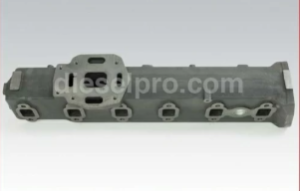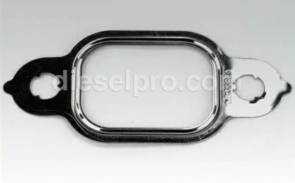
The exhaust system in Cummins 6B, 6BT, 6BTA, 4B, 4BT, and 4BTA engines plays a critical role in removing combustion gases, optimizing fuel efficiency, and reducing emissions. A well-maintained exhaust system ensures optimal engine performance, prevents excessive smoke, and reduces harmful emissions.
Exhaust & Related Components for Cummins 4B Marine & Industrial engine
Exhaust & Related Components for Cummins 4BT Marine & Industrial Engines
Exhaust & Related Components for Cummins 4BTA Marine & Industrial Engines
Exhaust & Related Components for Cummins 6B Marine & Industrial Engines
Exhaust & Related Components for Cummins 6BT Marine & Industrial Engines
Exhaust & Related Components for Cummins 6BTA Marine & Industrial Engines
This guide will cover:
✔ How to maintain the exhaust system for peak performance.
✔ How to inspect for leaks, damage, and blockages.
✔ Understanding emission control systems in Cummins B Series engines.
By following proper maintenance procedures, you can extend engine life, comply with emissions regulations, and maximize fuel efficiency.
Maintaining the Exhaust System for Optimal Performance

The exhaust system removes combustion gases, directs them away from the engine and operator, and helps control noise levels. A properly functioning exhaust system also enhances turbocharger efficiency and minimizes backpressure, ensuring smooth airflow.
Why Exhaust System Maintenance is Important
✔ Prevents Performance Loss – A clogged or damaged exhaust system can increase backpressure, reducing engine power.
✔ Optimizes Turbocharger Efficiency – A clean exhaust system ensures maximum airflow, reducing turbo lag.
✔ Reduces Fuel Consumption – A properly functioning exhaust system ensures optimal combustion, improving fuel economy.
✔ Prevents Harmful Gas Exposure – Exhaust leaks can expose the operator to toxic gases, leading to health hazards.
✔ Reduces Environmental Impact – Ensures the engine runs cleaner and within emissions compliance.
Key Components of the Exhaust System
✔ Exhaust Manifold: Collects gases from the cylinders and directs them to the turbocharger or exhaust pipe.
✔ Turbocharger (If Equipped): Uses exhaust gases to compress air for the intake, improving combustion efficiency.
✔ Exhaust Pipe: Directs gases away from the engine and vehicle or vessel.
✔ Muffler: Reduces engine noise and improves exhaust flow.
✔ Exhaust Gas Recirculation (EGR) System (If Equipped): Recirculates a portion of exhaust gases back into the intake to reduce emissions.
✔ Diesel Particulate Filter (DPF) (Newer Models): Captures soot and particulate matter to reduce emissions.
Inspecting for Leaks and Damage

Exhaust system leaks or damage can cause power loss, increased fuel consumption, excessive smoke, and noise. Regular inspections ensure early detection of issues before they cause major problems.
1. Common Signs of Exhaust System Issues
✔ Excessive Smoke (Black, White, or Blue) – Indicates combustion issues, fuel overuse, or oil burning.
✔ Loud or Unusual Exhaust Noise – May signal cracks, leaks, or a damaged muffler.
✔ Loss of Power or Turbo Lag – A sign of exhaust leaks affecting turbo efficiency.
✔ Burning Smell Inside the Cabin – Indicates exhaust gas leaks near the operator area.
✔ Higher Fuel Consumption – Restrictive exhaust flow causes inefficient combustion, leading to increased fuel use.
2. How to Inspect the Exhaust System
Step 1: Perform a Visual Inspection
- Check for cracks, rust, or damage on the exhaust manifold, pipes, and muffler.
- Look for black soot deposits, which may indicate leaks at the manifold gasket or exhaust joints.
Step 2: Listen for Unusual Noises
- A hissing sound may indicate a small exhaust leak.
- A loud roaring noise suggests a damaged muffler or broken pipe.
Step 3: Check for Exhaust Leaks Using the Soap Test
- Mix soap and water, apply it to suspected leak areas, and watch for bubbles when the engine runs.
Step 4: Inspect Turbocharger Connections (If Equipped)
- Ensure clamps, gaskets, and exhaust piping are secure.
- A loose connection can reduce boost pressure, causing power loss.
✔ Early detection of leaks prevents performance loss, excessive emissions, and fuel waste.
Understanding Emission Control Systems in Cummins B Series Engines
Modern diesel engines must comply with strict emissions regulations, leading to the adoption of various emission control technologies. While older Cummins B Series engines were mechanically simple, newer versions incorporate EGR, DPF, and other emissions-reducing systems.
1. Exhaust Gas Recirculation (EGR) System
The EGR system recirculates a portion of the exhaust gases back into the intake manifold to reduce nitrogen oxide (NOx) emissions.
✔ Benefits of the EGR System:
- Lowers NOx emissions by reducing combustion temperature.
- Helps meet EPA and international emissions regulations.
✔ Common EGR System Issues:
- Carbon buildup restricts exhaust flow, causing power loss.
- EGR valve failure leads to excess smoke, knocking, or engine hesitation.
✔ How to Maintain the EGR System:
- Inspect and clean EGR passages every 50,000 miles to prevent carbon buildup.
- Check EGR valve function using a diagnostic scanner or by manually operating the valve
2. Diesel Particulate Filter (DPF) System (Newer Models)
A Diesel Particulate Filter (DPF) captures soot and particulate matter, preventing harmful emissions from being released.
✔ Benefits of the DPF System:
- Reduces soot emissions by up to 90%.
- Improves air quality and meets emissions standards.
✔ Common DPF System Issues:
- Clogging or excessive soot buildup reduces engine performance.
- DPF regeneration failure leads to excessive black smoke and backpressure.
✔ How to Maintain the DPF System:
- Perform DPF regenerations as required by the engine’s control module.
- Use ultra-low sulfur diesel (ULSD) to reduce soot formation.
- Check for error codes related to the DPF system using a scanner.
3. Selective Catalytic Reduction (SCR) System (Newer Models)
Some modern Cummins engines use Selective Catalytic Reduction (SCR) to further reduce emissions. This system injects Diesel Exhaust Fluid (DEF) into the exhaust to neutralize NOx emissions.
✔ Benefits of the SCR System:
- Allows higher fuel efficiency while reducing emissions.
- Helps meet Tier 4 and EPA regulations.
✔ Common SCR System Issues:
- Low DEF levels trigger warning lights and may put the engine into limp mode.
- DEF system contamination leads to poor performance and increased NOx emissions.
✔ How to Maintain the SCR System:
- Refill DEF fluid regularly to prevent system faults.
- Use only high-quality DEF to avoid contamination.
- Check for leaks in DEF lines and injection nozzles.
Common Exhaust and Emission System Problems and Solutions
| Issue | Symptoms | Causes | Solutions |
| Exhaust Leak | Loud noise, power loss | Cracked exhaust manifold, loose clamps | Tighten clamps, replace gaskets |
| EGR Valve Failure | Power loss, black smoke | Carbon buildup | Clean or replace EGR valve |
| DPF Clogging | Excessive backpressure, black smoke | Soot accumulation | Perform manual DPF regeneration |
| Turbo Lag | Poor acceleration, black smoke | Leaky exhaust pipes, clogged filter | Inspect turbo piping and exhaust flow |
| High NOx Emissions | Fails emissions test, rough idle | SCR failure, low DEF | Refill DEF, check SCR sensors |
✔ Proper maintenance of the exhaust system and emission controls ensures compliance, efficiency, and long engine life.
Final Thoughts
Proper exhaust system and emissions control maintenance is crucial for Cummins 6B, 6BT, 6BTA, 4B, 4BT, and 4BTA engines to maintain performance, fuel efficiency, and regulatory compliance. By inspecting exhaust components, maintaining emission control systems, and addressing leaks early, you can:
✔ Ensure optimal engine performance.
✔ Comply with emissions regulations and avoid fines.
✔ Prevent costly repairs due to clogged or damaged components.
Exhaust & Related Components for Cummins 4B Marine & Industrial engine
Exhaust & Related Components for Cummins 4BT Marine & Industrial Engines
Exhaust & Related Components for Cummins 4BTA Marine & Industrial Engines
Exhaust & Related Components for Cummins 6B Marine & Industrial Engines
Exhaust & Related Components for Cummins 6BT Marine & Industrial Engines
Exhaust & Related Components for Cummins 6BTA Marine & Industrial Engines



 Free US Calls: 1-888-433-4735
Free US Calls: 1-888-433-4735 International: 305-545-5588
International: 305-545-5588